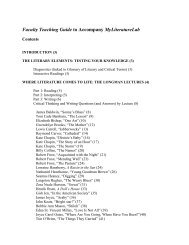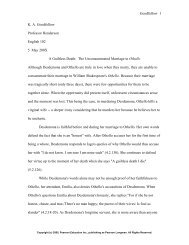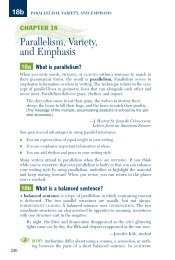chapter 3 - Pearson Learning Solutions
chapter 3 - Pearson Learning Solutions
chapter 3 - Pearson Learning Solutions
You also want an ePaper? Increase the reach of your titles
YUMPU automatically turns print PDFs into web optimized ePapers that Google loves.
2009934667<br />
Chapter 3 Nonverbal Communication 69<br />
Most people (except those who have been abused, raped, or brought up in a<br />
low- or no-touch family or society) associate appropriate touching with positive<br />
messages. 50 Those whose bodies have been invaded without permission, however,<br />
as in the case of sexual abuse, often pull back or feel uncomfortable when touched.<br />
In fact, touch avoidance is one of the signs counselors sometimes use to aid in the<br />
identification of clients who have been physically or sexually abused. 51<br />
If you have ever wondered why you felt comfortable, or uncomfortable, when<br />
you were touched, it could well have to do with your upbringing. Different cultures<br />
regard touch in different ways. Some avoid touch while others encourage it.<br />
The same is true within families. For example, in the United States, a moderatetouch<br />
society, “it is not unusual for an adult to pat the head of a small child who<br />
has been introduced by his or her parents. In Malaysia, and other Asian Pacific<br />
countries, touching anyone’s head—especially a child’s—is improper and considered<br />
an indignity because the head is regarded as the home of the soul.” 52 In the<br />
United States, a handshake is appropriate as a business greeting, a bow fulfills the<br />
same purpose in Japan, and kissing on both cheeks is the French custom.<br />
Touch is not only culture specific but also gender specific. Women in the European<br />
American culture tend to engage in more intimate same-sex touch than do<br />
men. Female pairs are more likely than male pairs to exchange hugs, kisses, and<br />
touches on the arm or back, and to do so for longer duration. 53 Heterosexual men<br />
touch one another using only narrowly circumscribed behaviors, such as handshaking<br />
or, in instances of extreme emotion (e.g., athletic accomplishments), hugging,<br />
butt slapping, or kissing. The acceptability of showing physical affection by<br />
women may be one of the reasons lesbians may be less discriminated against than<br />
gay men. 54 European Americans tend to react less to physical displays between<br />
women than between men. This is not true in other countries, such as Turkey,<br />
where it is acceptable for men to hold hands or kiss. In the United States, when<br />
Nonverbal communication<br />
is composed of all those<br />
messages that people<br />
exchange beyond the<br />
words themselves.<br />
Communicating: A Social and Career Focus, Tenth Edition, by Roy M. Berko, Andrew D. Wolvin, and Darlyn R. Wolvin. Published by Allyn & Bacon.<br />
Copyright © 2007 by <strong>Pearson</strong> Education, Inc.
















